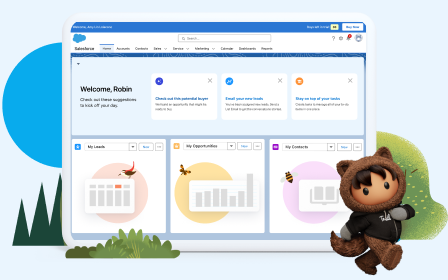Automate Your Business Process
Create Assignment Rules
Assignment rules define conditions that determine how leads or cases are processed. You’ve been asked by Customer Support team manager Kenya Collins to establish case rules so billing cases are routed to the correct queue.
Start by creating a new Billing Support Agents queue.
- Click the setup gear
 and select Setup.
and select Setup. - Enter
Queuesin the Quick Find box, then select Queues. - Click New and complete the details about the new queue:
Field Value Label Billing Support AgentsQueue Name (this field auto-populates) Send Email to Members Deselect - From the Available Objects list, select Case.
- Click Add to move Case to the Selected Objects list.
Next, add queue members.
- In the Queue Members section, search Users.
- From the Available Members list, select User: Aaron Hartzler and User: Fumiko Suzuki.
- Click Add to add to them to the Selected Members list, then click Save.

Then add a new rule entry to the Standard Case Assignment rule to route billing cases to the Billing Support Agents queue.
- From Setup, enter
Case Assignment Rulesin the Quick Find Box, then select Case Assignment Rules. - Click the Standard case assignment link, then click Edit.
- Select the Active checkbox to ensure this as the active case assignment rule, and click Save.
- Click New in the Rule Entries section and enter these details:
Field Value Step 1: Sort Order 2Step 2: Run this rule if the following criteria are met (1st row) Field Case: Status Operator equals Value New (click the lookup icon, select New and Insert Selected) (2nd row) Field Case: Case Record Type Operator equals Value Billing (click the lookup icon, select Billing and Insert Selected)
- In Step 3, select the picklist value Queue from the list.
- Click the lookup icon, then search for and select Billing Support Agents.
- Click Save.
Now create a new billing support case to test the assignment rule.
- Click the App Launcher
 and select Service.
and select Service. - Click the Cases tab.
- Click New.
- Select Billing and click Next.
- Complete the inquiry case details:
Note: If "Assign using active assignment rule" is not appearing when creating a new case, return to the Case Assignment Rule menu in Setup. Edit the Standard case assignment and uncheck the active checkbox and save. After saving, check the active checkbox again and save. This toggle will ensure "Assign using active assignment rule" appears when creating a new case.Field Value Contact Name
Sean Forbes
Account Name Edge CommunicationsProduct (choose any product from drop-down) Type Electronic Case Origin Phone Subject Renew WarrantyDescription Client wants to renew warranty on laptopAssign using active assignment rule Select
- Click Save.
Create Escalation Rules
Escalation rules automatically escalate a case when it meets the criteria you choose. Kenya would like her Customer Support team to be notified whenever a case regarding an issue with performance is logged. Set that up for them.
Start by creating a new escalation rule.
- Click the setup gear
 and select Setup.
and select Setup. - Enter
Escalation Rulesin the Quick Find Box, then select Escalation Rules. - Click New and fill in Rule Name:
Support. - Click the Active checkbox and click Save.
- Choose the new Support rule from the Case Escalation Rules list.
- Click New under Rule Entries and fill in these details:
Field Value Step 1: Sort Order 1Step 2: Run this rule if the following criteria are met Field Case: Case Reason Operator equals Value Performance (click the lookup icon, select Performance and Insert Selected) - Click Save.
Now update the Rule Entries of the newly created Support escalation rule.
- Click New under Escalation Actions and enter the Age Over value to
1. - In the Notify This User field select the Lookup then search for and click on your name.
- For the Notification Template select the Lookup, navigate to the Unfiled Public Classic Email Templates folder, and choose the Support: Escalated Case Notification template.
- Click Save.
Create a new Product Support case for Edge Communications and review the escalation actions in the Case Escalations queue.
- Click the App Launcher
 and select Service.
and select Service. - Click the Cases tab.
- Click New, then select Product Support as record type and click Next.
- Fill in the new case record details:
Field Value Contact Name
Sean Forbes
Account Name Edge CommunicationsProduct (choose any product from the drop-down) Type Electronic Case Origin Email Case Reason Performance Subject Laptop not workingDescription Client laptop is not workingAssign using active assignment rule Select - Click Save.
- Copy the case number of the case you just created.
- From Setup, enter
Case Escalationsin the Quick Find Box, then select Case Escalations. - Filter the case escalations queue to show the case you just created by entering the criteria: Case To Escalate equals [case number for the case you just created].
- Click Search. Note the escalation actions in the queue and when can you expect to see an escalation alert email for this case.
Congratulations! You finished the project and customized your org. From setting up users and managing Chatter to creating record types and processes, with these building blocks in your toolbox, you’re well on on your way to becoming an expert Salesforce admin.

